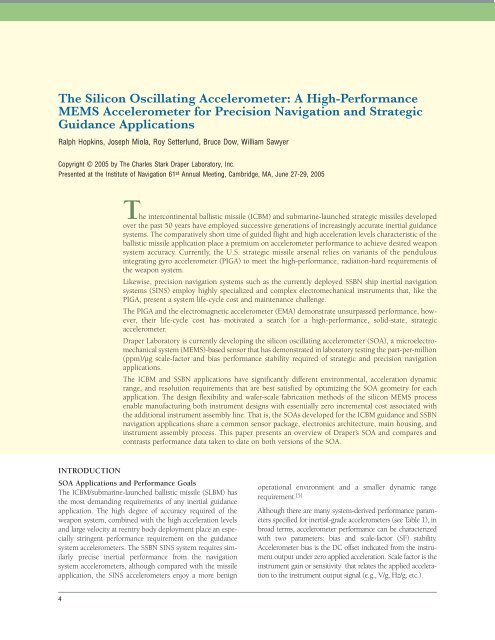TECHNOLOGY DIGEST - Draper Laboratory
TECHNOLOGY DIGEST - Draper Laboratory
TECHNOLOGY DIGEST - Draper Laboratory
You also want an ePaper? Increase the reach of your titles
YUMPU automatically turns print PDFs into web optimized ePapers that Google loves.
The Silicon Oscillating Accelerometer: A High-Performance<br />
MEMS Accelerometer for Precision Navigation and Strategic<br />
Guidance Applications<br />
Ralph Hopkins, Joseph Miola, Roy Setterlund, Bruce Dow, William Sawyer<br />
Copyright © 2005 by The Charles Stark <strong>Draper</strong> <strong>Laboratory</strong>, Inc.<br />
Presented at the Institute of Navigation 61 st Annual Meeting, Cambridge, MA, June 27-29, 2005<br />
INTRODUCTION<br />
SOA Applications and Performance Goals<br />
The ICBM/submarine-launched ballistic missile (SLBM) has<br />
the most demanding requirements of any inertial guidance<br />
application. The high degree of accuracy required of the<br />
weapon system, combined with the high acceleration levels<br />
and large velocity at reentry body deployment place an especially<br />
stringent performance requirement on the guidance<br />
system accelerometers. The SSBN SINS system requires similarly<br />
precise inertial performance from the navigation<br />
system accelerometers, although compared with the missile<br />
application, the SINS accelerometers enjoy a more benign<br />
4<br />
The intercontinental ballistic missile (ICBM) and submarine-launched strategic missiles developed<br />
over the past 50 years have employed successive generations of increasingly accurate inertial guidance<br />
systems. The comparatively short time of guided flight and high acceleration levels characteristic of the<br />
ballistic missile application place a premium on accelerometer performance to achieve desired weapon<br />
system accuracy. Currently, the U.S. strategic missile arsenal relies on variants of the pendulous<br />
integrating gyro accelerometer (PIGA) to meet the high-performance, radiation-hard requirements of<br />
the weapon system.<br />
Likewise, precision navigation systems such as the currently deployed SSBN ship inertial navigation<br />
systems (SINS) employ highly specialized and complex electromechanical instruments that, like the<br />
PIGA, present a system life-cycle cost and maintenance challenge.<br />
The PIGA and the electromagnetic accelerometer (EMA) demonstrate unsurpassed performance, however,<br />
their life-cycle cost has motivated a search for a high-performance, solid-state, strategic<br />
accelerometer.<br />
<strong>Draper</strong> <strong>Laboratory</strong> is currently developing the silicon oscillating accelerometer (SOA), a microelectromechanical<br />
system (MEMS)-based sensor that has demonstrated in laboratory testing the part-per-million<br />
(ppm)/µg scale-factor and bias performance stability required of strategic and precision navigation<br />
applications.<br />
The ICBM and SSBN applications have significantly different environmental, acceleration dynamic<br />
range, and resolution requirements that are best satisfied by optimizing the SOA geometry for each<br />
application. The design flexibility and wafer-scale fabrication methods of the silicon MEMS process<br />
enable manufacturing both instrument designs with essentially zero incremental cost associated with<br />
the additional instrument assembly line. That is, the SOAs developed for the ICBM guidance and SSBN<br />
navigation applications share a common sensor package, electronics architecture, main housing, and<br />
instrument assembly process. This paper presents an overview of <strong>Draper</strong>’s SOA and compares and<br />
contrasts performance data taken to date on both versions of the SOA.<br />
operational environment and a smaller dynamic range<br />
requirement. [5]<br />
Although there are many system-derived performance parameters<br />
specified for inertial-grade accelerometers (see Table 1), in<br />
broad terms, accelerometer performance can be characterized<br />
with two parameters: bias and scale-factor (SF) stability.<br />
Accelerometer bias is the DC offset indicated from the instrument<br />
output under zero applied acceleration. Scale factor is the<br />
instrument gain or sensitivity that relates the applied acceleration<br />
to the instrument output signal (e.g., V/g, Hz/g, etc.).

















